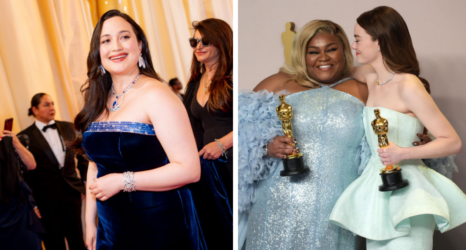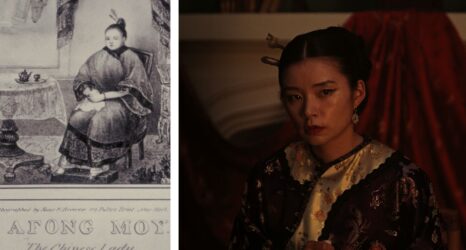Chris Rock’s new film, Top Five, has been lauded as a funny and provocative work that showcases groups generally marginalized in movies, including people of color and strong women. But critical backlash has highlighted the way in which the movie strips its leading lady of her supposed intellect and instead turns her into what New York Magazine quite accurately dubs a “slutty ambition monster.”
In the trope-y style of romantic comedies, Top Five tells the familiar story of a boy-meets-girl attraction. Rock, who wrote, directed and starred in the movie, plays Andre Allen, a comedic actor looking to redefine his cinematic reputation with a “serious” role (though he intends to do so by acting in a film that essentially mocks the Haitian Revolution). Rosario Dawson plays his female counterpart, New York Times journalist Chelsea Brown, who meets Allen when she is assigned to interview him for a story.
“So, are you a real journalist or, like, Miss Detroit?” begins their interaction when Allen spots her on the sidewalk as he’s leaving a Manhattan office building. And just as she’s making a loose attempt to convince him that she is in fact a professional, Brown asks if Allen—a hugely famous actor whom she is meant to be interacting with in a work setting—would mind making a brief stop at her apartment before commencing the interview because she “forgot her recorder.”
Of course Allen agrees. While in her apartment, Brown takes the opportunity to change out of her work clothes and into a floral dress, casually explaining to Allen that she has a date with her boyfriend after the interview. As if the movie is trying to discredit Brown’s character in every possible way, her mother (who is in the apartment babysitting Brown’s daughter) ambushes Allen with one of her daughter’s printed stories that provides dating advice. Within these first five minutes onscreen, Brown’s character has already been portrayed as forgetful, frivolous and ultimately amateurish.
She proceeds to follow Allen around the city for the remainder of the day, periodically asking him interview questions in between crass remarks about her previous drug addiction, sexual promiscuity and borderline psychopathic pranks to punish her homosexual boyfriend. These scenes are peppered with small moments that supposedly make Brown’s character seem more complex: She’d like to see a gay, Latina woman president; she’s bisexual; she was a teenage mother, etc. As anticipated, these conversations culminate in the two characters fooling around in a dimly lit restaurant bathroom. The film is clearly a comedy and not meant to entirely reflect true situations or people, but the extent to which no one in this film takes Brown seriously (including Brown herself) is distracting to the point of being unbelievable.
Since this is a rom-com, it makes sense that Rock and Dawson’s characters would develop a mutual attraction during the course of the film. However, what might have been flirtatious, witty banter reads as bizarre, given the supposedly “professional” circumstances under which they meet. Allen and Brown seem to shamelessly ignore the fact that Brown’s behavior is blatantly unethical.
Real-life journalists take great precautions to avoid producing biased or potentially libelous copy. We are taught to conduct thorough, accurate research, factcheck said research and interview a variety of sources. Admittedly, there are some exploitative journalists, but that does not mean that women reporters typically use sexuality to lure our subjects. In Top Five, Brown is immediately regarded as a sexual object, and she only reinforces the stereotype.
Top Five is certainly not the only film to play out this trope. Perhaps the most prominent current example is the critically acclaimed Netflix drama House of Cards, wherein one of the major plot points is the unscrupulous nature of female journalists on Capitol Hill, who boast of their willingness to “suck, screw and jerk anything that moved” to get a story.
Similarly, the 2005 comedy Thank You For Smoking chronicled the relationship between a morally stunted tobacco lobbyist and a journalist who seduces him in order to expose the inner workings of his company. This film, at least, recognizes the ethical error, and the journalist is penalized for her suspicious reporting. But even lighthearted rom-com’s like How to Lose a Guy in 10 Days and Never Been Kissed build relationships between characters based on the premise of a female journalist seducing a man for an “assignment.”
The reality of slaving over a laptop keyboard for hours on end is far too tedious for cinema, whether the journalist is female or male. However, male journalists in television and film tend to have other character flaws rather than just sexual promiscuity. Jeremy Renner’s 2014 drama Kill the Messenger, a biopic about investigative journalist Gary Webb, showcases the obsessive side of reporting (Webb kills himself after losing his reporting job). Even more disturbing is the 2014 noir thriller Nightcrawler, which depicts Jake Gyllenhaal as the scummiest of freelance journalists, manipulating everyone in his path in order to gather information. He does employ sex as a reporting tactic in one scene opposite Rene Russo, though it is depicted as a violent and intrusive act and is much more a reflection of Gyllenhaal as sociopath rather than seducer.
We used to see women journalist characters that were at least spunky and independent—think the fiery Mary Tyler Moore “making it on her own” in her self-titled 70’s television show. Maybe Hollywood has, since then, been too heavily influenced by the stiletto’d lifestyle of one of the most iconic fictional female journalists—Sex and the City‘s Carrie Bradshaw, who, like Chelsea Brown, reported for the Times. But at least Bradshaw was candid about her intentions: She was getting paid specifically to write about sex.
Get Ms. in your inbox! Click here to sign up for the Ms. newsletter.





